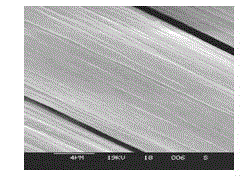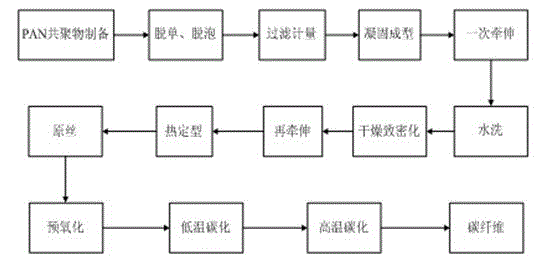Preparation method of wet-process high-strength polyacrylonitrile-based carbon fiber
A polyacrylonitrile-based carbon fiber and high-strength technology, which is applied in the fields of fiber chemical characteristics, textiles and papermaking, can solve the problems of gelation and time-consuming spinning solution system, and achieve less hole-type defects, reduce devitrification and impermeability Homogeneity, the effect of improving the uniformity of solidification diffusion
- Summary
- Abstract
- Description
- Claims
- Application Information
AI Technical Summary
Problems solved by technology
Method used
Image
Examples
Embodiment 1
[0041] Example 1: Using azobisisobutyronitrile (AIBN) as the initiator and dimethyl sulfoxide (DMSO) as the solvent, acrylonitrile solution copolymerization was carried out. Based on the total mass of the comonomers, put the monomers and comonomers methyl acrylate and itaconic acid into the polymerization kettle at the ratio of 97.2% of acrylonitrile, 1.6% of methyl acrylate and 1.2% of itaconic acid, and then add Solvent DMSO, control the monomer acrylonitrile to account for 22% of the total mass of the polymerization system, react at 65°C for 24 hours, and the resulting polymerization solution is defoamed and subjected to wet spinning. The spinning solution enters the coagulation bath through the metering pump, candle filter, and spinneret. In the three coagulation baths with the concentration of the good solvent DMSO solution of 67%, 45%, and 15%, the corresponding coagulation bath temperature is 60. Under the conditions of ℃, 20℃, and 20℃, perform gradient gelation coagulat...
Embodiment 2
[0042] Example 2: According to the polymerization formula and quantity of Example 1, it was charged into the polymerization kettle, and the same process conditions were used to carry out polymerization reaction, de-sizing and defoaming. The spinning solution passes through a metering pump, a candle filter, and a spinneret. The DMSO solution concentration in the coagulation bath is 74.5%, 45%, and 15% respectively. The three coagulation baths are gradient gelled and coagulated. The coagulation bath temperature is 20. ℃, 20℃, 20℃, in the first coagulation bath, add diethylamine solution, adjust the pH of the coagulation bath = 10.5, and prepare PAN-based precursor yarn through the same follow-up spinning process as the comparative example. The fineness of the raw silk is 1.24dtex, and the bulk density is 1.190g / cm 3 The pore volume content determined by the SAXS method is 0.43%. The precursor is pre-oxidized in an air atmosphere at 200-280°C, carbonized at a low temperature in a n...
Embodiment 3
[0043] Example 3: According to the polymerization formula and quantity of Example 1, polymerization, de-ordering, and defoaming were performed. The spinning solution enters the coagulation bath through the metering pump, candle filter, and spinneret. The coagulation bath contains ethylenediamine, adjusted to pH=10.3, and the concentration in the coagulation bath is 64%, 45%, and 15% respectively. The medium gradient gelation coagulation molding, the coagulation bath temperature is 60°C, 20°C, and 20°C, respectively, and the PAN-based precursor yarn is prepared through the same follow-up spinning process as the comparative example. The fineness of the prepared raw yarn is 1.25dtex, and the bulk density is 1.191g / cm 3 The pore volume content determined by the SAXS method is 0.32%. The raw silk is pre-oxidized under 200-280℃ air atmosphere, low-temperature carbonization treatment under 350-800℃ nitrogen atmosphere, and 800-1600℃ nitrogen atmosphere Under high temperature carboniza...
PUM
| Property | Measurement | Unit |
|---|---|---|
| diameter | aaaaa | aaaaa |
| tensile strength | aaaaa | aaaaa |
| density | aaaaa | aaaaa |
Abstract
Description
Claims
Application Information
 Login to View More
Login to View More - R&D
- Intellectual Property
- Life Sciences
- Materials
- Tech Scout
- Unparalleled Data Quality
- Higher Quality Content
- 60% Fewer Hallucinations
Browse by: Latest US Patents, China's latest patents, Technical Efficacy Thesaurus, Application Domain, Technology Topic, Popular Technical Reports.
© 2025 PatSnap. All rights reserved.Legal|Privacy policy|Modern Slavery Act Transparency Statement|Sitemap|About US| Contact US: help@patsnap.com



